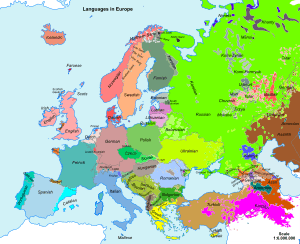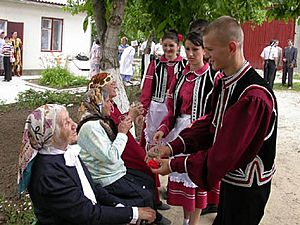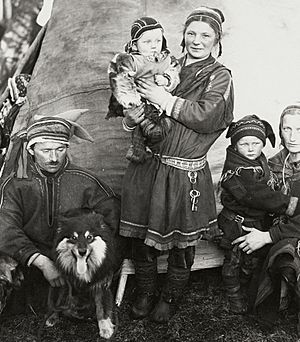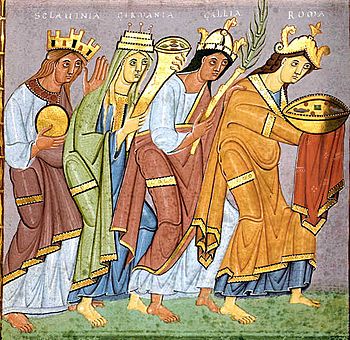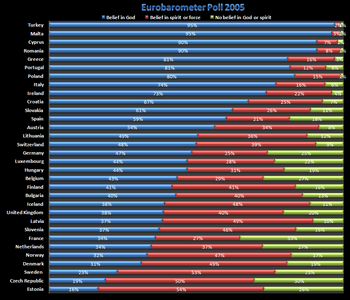Ethnic groups in Europe facts for kids
The indigenous peoples of Europe are the different groups of people who have lived in Europe for a very long time. Experts who study these groups, called ethnologists, look at things like shared family history or common languages to define them.
One study from 2002 found there are 87 different indigenous peoples in Europe. About 33 of these groups make up the main population in at least one country. The other 54 groups are minorities. In total, about 105 million people in Europe belong to national or language minority groups. That's about 14% of all Europeans! The Russians are the largest group, with over 134 million people.
Sometimes, words like "ethnic group," "people," and "nationality" are used to mean similar things when talking about Europe's different populations.
Contents
Europe's People: A Quick Look
Around 20-25 million people in Europe (about 3%) are from families who originally came from outside Europe. The European Union (EU) has about 500 million people, which is two-thirds of Europe's total population.
Spain and the United Kingdom are interesting cases. In these countries, being "Spanish" or "British" can mean being part of a larger group that includes many smaller, regional groups. For example, in Spain, there are also Catalans and Basques. Switzerland is similar, where people are grouped by the languages they speak, like German, French, or Italian.
Languages of Europe
Europe has about 740 million people (as of 2010). A huge number of them, about 90% (or 650 million), speak languages from three main branches of the Indo-European languages family:
- Romance languages: These languages come from Latin, the language of ancient Rome. Examples include French, Italian, Spanish, Portuguese, and Romanian.
- Germanic languages: These include German, English, Dutch, Swedish, and Norwegian.
- Slavic languages: You'll find these mostly in Eastern Europe. Examples are Russian, Polish, Ukrainian, Czech, and Serbian.
Some other Indo-European languages in Europe don't fit into these big groups:
- Greek (spoken by about 12 million people)
- Albanian (spoken by about 9 million people)
- Armenian (spoken by about 3.5 million people)
There are also smaller Indo-European language groups:
- Baltic languages: Like Latvian and Lithuanian.
- Celtic languages: Such as Irish, Welsh, and Scottish Gaelic.
- Iranic languages: Mainly Ossetian in the Caucasus mountains.
- Indo-Aryan languages: The Romani language, spoken by Roma people, is related to languages from India.
Besides Indo-European languages, Europe has other language families that are completely different:
- Uralic languages: Including Finnish, Estonian, and Hungarian.
- Turkic languages: Such as Turkish, Azeri, and Tatar.
- Semitic languages: Like Maltese and Hebrew (spoken by some Jewish communities).
- Kartvelian languages: Found in the Caucasus, including Georgian.
- Northwest Caucasian languages: Like Abkhaz and Circassian.
- Northeast Caucasian languages: Such as Chechen and Avar.
- Language isolates: Basque, spoken in parts of Spain and France, is unique and not related to any other known language.
- Mongolic languages: The Kalmyk language is spoken in a region of Russia.
History of European Peoples
Ancient Times
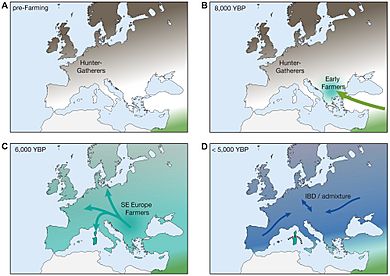
Scientists believe that the Basques are direct descendants of people who lived in Europe during the late Neolithic (New Stone Age) or early Bronze Age.
Many of the Indo-European groups in Europe likely formed when early Indo-European people, who migrated from the Pontic steppe (a large grassland in Eastern Europe and Asia) around 3,000 years ago, mixed with the people already living there.
The Finnic peoples (like Finns and Estonians) are thought to have come from people who lived near the Ural Mountains in the east. They moved to their current homes in Europe about 3,000 years ago.
Historical Groups
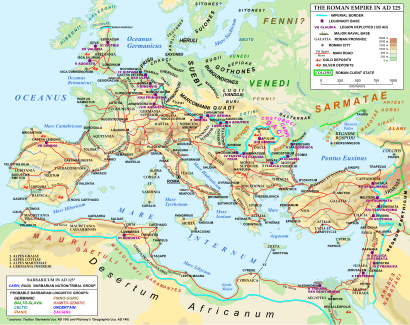
We know about many groups from the Iron Age (before the big migrations) thanks to ancient Greek and Roman writers like Herodotus and Tacitus. Here are some of them:
- Around the Aegean Sea: The ancient Greek tribes.
- In the Balkans: The Illyrians, Dacians, and Thracians.
- On the Italian Peninsula: The Etruscans, Italic peoples, and Greek colonies.
- Western and Central Europe: The Celts (like the Gauls), and Germanic peoples.
- Iberian Peninsula (Spain and Portugal): The Iberians, Celts, Basques, and Phoenicians.
- British Isles: The Celtic tribes and Picts.
- Northern Europe: The Baltic Finns and Germanic peoples.
- Eastern Europe: The Veneti (early Slavs), Scythians, and Sarmatians.
New Arrivals in History
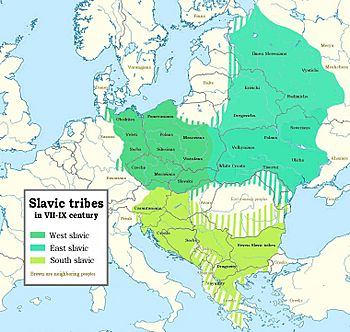
Over time, many groups arrived in Europe from other parts of the world:
- Phoenician colonies: From about 1200 BC, people from Phoenicia (modern-day Lebanon) set up colonies around the Mediterranean Sea, including in Spain, Sicily, and Sardinia.
- Assyrian influence: The Neo-Assyrian Empire (911–605 BC) conquered parts of the Caucasus and Turkey.
- Iranian influence: Groups like the Scythians and Sarmatians came from the Iranian regions.
- Jewish diaspora: Jewish communities began to settle in Europe during the Roman Empire period, starting around 70 AD.
- Huns: The Huns arrived in the 5th century AD, leading to big changes and the formation of new kingdoms.
- Slavic migrations: In the 6th century AD, Slavic peoples spread across Eastern and Central Europe, forming the groups we know today as Eastern, Western, and Southern Slavs.
- Bulgars: These nomadic people from Central Asia eventually settled in the Balkans and mixed with the Slavs.
- Magyars: The Magyars (Hungarians) arrived in Europe around the 8th century.
- Arabs: From the 8th century onwards, Arabs conquered parts of Spain (called Al-Andalus), Sicily, and some coastal areas of Italy. They were later expelled from Spain in 1492.
- Berbers: Dynasties from North Africa, like the Almoravides, ruled much of Spain and Portugal.
- Cumans: These western Turkic people entered Ukraine in the 11th century.
- Mongols and Tatars: The Mongol and Tatar invasions (1223–1480) and later Ottoman rule (1389–1878) brought Turks and Tatars to Europe.
- Romani people: The Romani people arrived in Europe during the late Middle Ages.
- Kalmyks: The Mongol Kalmyks arrived in Russia in the 17th century.
Minority Groups in Europe
A "minority group" is a group of people who are different from the main population in a country, often because of their language, culture, or background. About 105 million people in Europe belong to national minority groups.
Many countries in Europe have signed an agreement called the Framework Convention for the Protection of National Minorities. This agreement helps make sure that countries respect the rights of minority groups, fight against unfair treatment, and help keep their cultures and languages alive.
Indigenous Minorities
Some groups have been in Europe for a very, very long time, even before many of the major migrations. These include:
- The Basques in Spain and France.
- The ancient Etruscans in Italy.
- The Sardinians and Corsicans on their islands.
Non-Indigenous Minorities
Many groups have moved to Europe over the centuries, especially in the 20th and 21st centuries. Often, they come from countries that used to be colonies of European empires.
Here are some examples of non-indigenous minority groups:
- People from Western Asia: This includes Turks (many in Germany, France, and the Balkans), Jews (mostly in France, UK, and Russia), Assyrians, and Kurds.
- People from Africa: This includes North Africans (many in France, Spain, and Italy) and Sub-Saharan Africans (many in the UK and France).
- People from Latin America: Many Latin Americans live in Spain, Italy, and the UK.
- People from South Asia: This includes Romani (found across Europe, especially the Balkans), Indians, Pakistanis, and Bangladeshis (many in the UK and Italy).
- People from Southeast Asia: Such as Filipinos (many in Italy and the UK) and Vietnamese (in France and Germany).
- People from East Asia: Including Chinese (many in France, Russia, and the UK) and Japanese.
- People from North America: Including Americans and Canadians who have moved to Europe.
What Makes Europe "Europe"?
European culture is built on a "common cultural heritage." This means many ideas and traditions are shared across the continent. Some key parts of this shared culture include:
- Ideas from ancient Greece and Rome, Christianity, the Renaissance (a time of great art and learning), and the Enlightenment (a time of new ideas about freedom and government).
- A rich history of inventions and industries that spread around the world.
- A strong belief in human rights and individual freedom.
- Many different countries and governments that have learned to live together.
- Respect for people and countries outside of Europe.
These ideas have helped shape what we call "Western culture," which has also influenced countries like those in the Americas and Australia.
Religion in Europe
For a long time, Christianity has been the main religion in most of Europe. There are three main types of Christianity:
- Roman Catholic: Common in Western and Central Europe.
- Protestant: Mostly found in Northern Europe.
- Eastern Orthodox: Common in Eastern and Southern Slavic regions, Romania, Moldova, and Greece.
Christianity has greatly influenced European art, science, and ways of thinking for over 1,700 years. In 2011, about 76% of Europeans said they were Christian.
Islam also has a long history in parts of Europe, especially in the Balkans and the Caucasus, due to the Ottoman Empire. Today, Muslims make up the majority of people in Albania, Azerbaijan, Kosovo, and Bosnia and Herzegovina. Many Muslims have also moved to Western Europe in recent times.
Judaism has been present in Europe for thousands of years, but it is a smaller religion today. Most Jewish people in Europe live in France, the UK, Germany, Russia, and Ukraine.
In modern times, many people in Europe have become less religious. This is called secularization. For example, in the Czech Republic and Estonia, many people say they don't belong to any religion.
A European Identity?
"Pan-European identity" means feeling a connection to Europe as a whole, or to the European Union. This feeling has grown as European countries have worked more closely together, especially since the 1990s.
Sometimes, "Europe" is used to mean just the European Union, even though many millions of people live in Europe but not in EU countries. This idea of a "pan-European" identity is often compared to feeling proud of your own country.
European Groups by Country
Here's a look at the main groups and minorities in different European countries:
| Country | Main Group | % | Other Major Groups | Minorities |
|---|---|---|---|---|
| Albania | Albanians | 82.58% | Greeks ~3%, Aromanians, Romani, Macedonians, Montenegrins, Bulgarians, Serbs. | |
| Armenia | Armenians | 98.1% | Russians, Yazidis, Assyrians, Kurds, Greeks, Jews. | |
| Austria | Austrians | 91.1% | South Slavs 4% (includes Croats, Slovenes, Serbs, Bosniaks), Turks 1.6%, Germans 0.9%. | |
| Azerbaijan | Azerbaijanis | 91.6% | Lezgin 2% | Armenians, Russians, Talysh, Avars, Turks, Tatars, Ukrainians, Poles. |
| Belarus | Belarusians | 83.7% | Russians 8.3%, Poles 3.1%, Ukrainians 1.7%. | |
| Belgium | Flemings | 58% | Walloons 31%, Germans 1% | Mixed or other 10%. |
| Bosnia and Herzegovina | Bosniaks | 50.11% | Serbs 30.78%, Croats 15.43% | Other 2.73%. |
| Bulgaria | Bulgarians | 84% | Turks 8.8% | Roma 5%, Others 2% (including Russians, Armenians, Tatars). |
| Croatia | Croats | 90% | Serbs 4.5%, other 5.9% (including Bosniaks, Hungarians, Slovenes, Czechs). | |
| Czech Republic | Czechs | 90.4% | Moravians 3.7% | Slovaks 1.9%. |
| Denmark | Danes | 90% | Faroese, Greenlanders | Other Scandinavians, Germans, Frisians, other Europeans. |
| Estonia | Estonians | 68% | Baltic Russians 25.6% | Ukrainians 2.1%, Belarusians 1.3%, Finns 0.9%. |
| Finland | Finns | 93.4% | Swedish-speaking Finns 5.6%, Sami 0.1% | Russians 1.1%, Estonians 0.7%, Romani 0.1%. |
| France | French | (Includes regional groups like Bretons, Corsicans, Occitans, Basques, Catalans). | Other European 7%, North African 7%, Sub-Saharan African, Asian, Latin American. | |
| Germany | Germans | 81%–91% | (Includes Bavarians, Swabians, Saxons, Frisians, Sorbs). | Germans with immigrant background 10%; Foreigners 9% (Turks 2.1%, others 6.7%). |
| Georgia | Georgians | 86.8% | Russians, Azerbaijanis, Armenians, Ukrainians, Greeks, Ossetians. | |
| Greece | Greeks | 93% | (Includes linguistic minorities 3%) | Albanians 4% and other (Aromanians, Megleno-Romanians, Cretan Turks) 3%. |
| Hungary | Hungarians | 92.3% | Romani 1.9%, Germans 1.2%, other (Croats, Romanians, Bulgarians, Turks) 4.6%. | |
| Iceland | Icelanders | 91% | Other (non-native/immigrants – mainly Polish, Lithuanians, Danes, Germans, Latvians) 9%. | |
| Ireland | Irish | 87.4% | Other white (Latvian, Polish, Ukrainian) 7.5%, Asian 1.3%, black 1.1%, mixed 1.1%. | |
| Italy | Italians | 91.7% | German-speaking population in South Tyrol | Historical minorities (Sardinian, French, Occitan, Croatian, Albanian, Catalan, German, Greek, Ladin, Friulian, Slovene, Romani), other Europeans 4%, North African Arabs 1%, others 2.5%. |
| Kazakhstan | Kazakhs | 63.1% | Russians 23.7% | Uzbeks, Ukrainians, Uyghurs, Tatars, Kyrgyz, Tajiks, Germans, Poles, Koreans. |
| Kosovo | Albanians | 92% | Serbs 4% | Other 4% (Bosniaks, Gorani, Romani, Turks). |
| Latvia | Latvians | 62.1% | Baltic Russians 26.9% | Belarusian 3.3%, Ukrainian 2.2%, Polish 2.2%, Lithuanian 1.2%. |
| Lithuania | Lithuanians | 83.5% | Poles 6.74%, Russians 6.31%, Belarusians 1.23%. | |
| Malta | Maltese | 95.3% | ||
| Moldova | Moldovans | 75.1% | Gagauzs 4.6%, Bulgarians 1.9% | Romanians 7%, Ukrainians 6.6%, Russians 4.1%. |
| Montenegro | Montenegrins | 44.98% | Serbs 28.73% | Bosniaks 8.65%, Albanians 4.91%. |
| Netherlands | Dutch | 80.7% | Frisians 3% | Other European Union nationals 5%, Indonesians 2.4%, Turks 2.2%, Surinamese 2%, Moroccans 2%. |
| North Macedonia | Macedonians | 64% | Albanians 25.2%, Turks 4% | Romani 2.7%, Serbs 1.8%. |
| Norway | Norwegians | 85–87% | Sami 0.7%, Kvens 0.2% | Poles 2.10%, Swedes, Somalis, Arabs, Kurds, Vietnamese, Germans, Lithuanians, Russians. |
| Poland | Poles | 97% | Germans 0.4%, Belarusians 0.1%, Ukrainians 0.1%. | |
| Portugal | Portuguese | 95% | Portuguese Mirandese speakers 15.000~ | Other 5% – other Europeans, Africans from Portuguese-speaking Africa, Brazilians, Chinese, Indians, Jews, Romani. |
| Romania | Romanians | 83.4% | Hungarians 6.1% | Romani 3.0%, Germans 0.2%, Ukrainians 0.2%, Turks 0.2%, Russians 0.1%. |
| Russia | Russians | 81% | Tatars 3.9%, Chuvashes 1%, Chechens 1%, Ossetians 0.4%, Kabardin 0.4%, Ingushes 0.3%, Kalmyks 0.1% | Ukrainians 1.4%, Bashkirs 1.2%, Armenians 0.9%, Avars 0.7%. |
| Serbia | Serbs | 83% | Hungarians 3.9%, Romani 1.4%, Bosniaks 1.8%, Montenegrin 0.9%. | |
| Slovakia | Slovaks | 86% | Hungarians 9.7% | Romani 1.7%, Ruthenian/Ukrainian 1%. |
| Slovenia | Slovenes | 83.1% | Serbs 2%, Croats 1.8%, Bosniaks 1.1%. | |
| Spain | Spaniards | 89% | Various nationalities and sub-ethnicities (Andalusians, Castilians, Catalans, Galicians, Basques). | Gypsies, Jews, Latin Americans, Romanians, North Africans, sub-Saharan Africans, Chinese, Filipinos, British. |
| Sweden | Swedes | 88% | Finns (Tornedalians), Sami people | Foreign-born or first-generation immigrants: Finns, Yugoslavs, Danes, Norwegians, Russians, Arabs, Syriacs, Greeks, Turks, Iranians, Iraqis, Pakistanis, Thais, Koreans, Chileans. |
| Switzerland | Germans | 65% | Regional linguistic subgroups (Alamannic German-speakers, Romand French-speakers 24.4%, Italian-speakers 7%, Romansh people). | Balkans (Serbs, Croats, Bosniaks, Albanians) 6%, Italians 4%, Portuguese 2%, Germans 1.5%, Turks 1%, Spanish 1%. |
| Turkey | Turks | 75% | Kurds 18% | Other 7%: Zaza, Laz, Jews, Greeks, Georgians, Circassians, Bulgarians, Bosniaks, Assyrians, Armenians, Arabs, Albanians, Romanians. |
| Ukraine | Ukrainians | 77.8% | Russians 17.3% | Belarusians 0.6%, Moldovans 0.5%, Crimean Tatars 0.5%, Bulgarians 0.4%, Hungarians 0.3%, Romanians 0.3%, Poles 0.3%, Jews 0.2%, Armenians 0.1%. |
| United Kingdom | White British | 81.9% | (Consisting of English: ca. 75–80%, Scottish: 8.0%, Welsh: approx. 4.5%, Northern Irish: 2.8%, also Cornish, Manx, Channel Islanders). | African British, Asian British (South Asian and East Indian), Chinese British, British Jews, Romani, other Commonwealth Citizens and other Europeans (Irish, Poles, French). |
Images for kids
-
Europa Regina (Representation of Europe printed by Sebastian Munster (1570).
See also
 In Spanish: Etnias de Europa para niños
In Spanish: Etnias de Europa para niños


